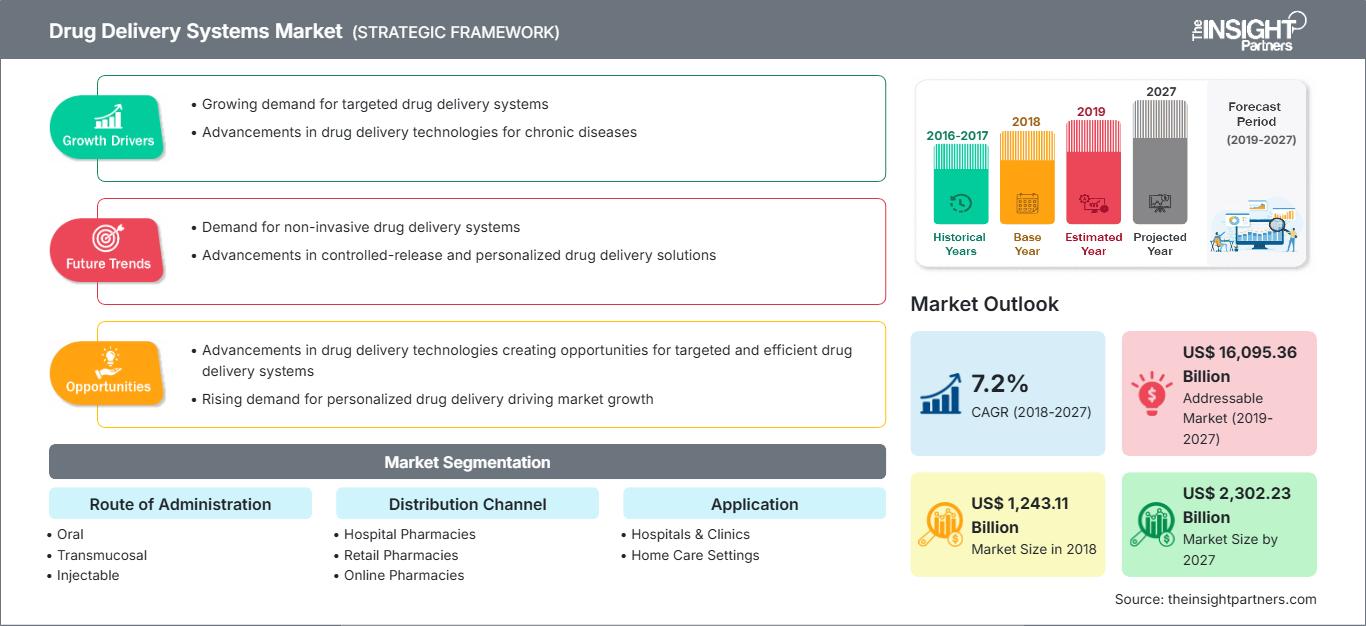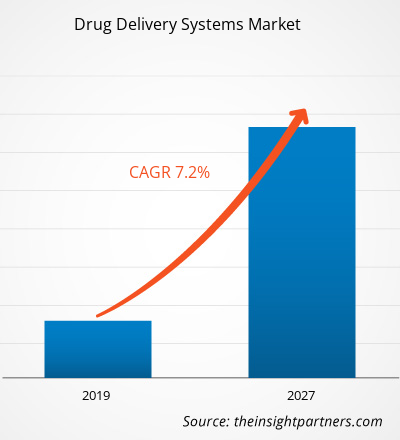[Forschungsbericht] Der Markt für Arzneimittelabgabesysteme wurde 2018 auf 1.243.111,7 Millionen US-Dollar geschätzt und soll bis 2027 2.302.227,2 Millionen US-Dollar erreichen; von 2019 bis 2027 wird ein durchschnittliches jährliches Wachstum von 7,2 % erwartet.
Analystenperspektive:
Der globale Markt für Arzneimittelabgabesysteme wird maßgeblich durch die zunehmende Verbreitung chronischer Krankheiten wie Diabetes, Herz-Kreislauf-Erkrankungen und Krebs sowie durch technologische Fortschritte bei der Herstellung und Entwicklung innovativer Geräte zur Arzneimittelabgabe vorangetrieben. Diabetes ist eine der Hauptursachen für Nierenversagen, Herzinfarkte, Blindheit und Schlaganfälle. Die weltweit rasant steigende Zahl chronischer Krankheiten führt zu einem deutlichen Anstieg der Nachfrage nach innovativen Medikamenten, was wiederum das Marktwachstum für Arzneimittelverabreichungssysteme begünstigt.
Die rasant wachsende Biopharmaindustrie und die Entwicklung neuer und innovativer Medikamente treiben das Wachstum des Marktes für Arzneimittelverabreichungssysteme maßgeblich voran. Die steigenden Investitionen führender Pharmahersteller in die Forschung und Entwicklung neuer Medikamente zur Behandlung unheilbarer Krankheiten erhöhen den Bedarf an pharmazeutischen Arzneimittelverabreichungslösungen weltweit. Darüber hinaus treiben mehrere führende Akteure im Markt für Arzneimittelverabreichungssysteme und ihre zentralen Entwicklungsstrategien wie Produkteinführungen, Fusionen und Übernahmen sowie Partnerschaften das Marktwachstum maßgeblich voran. Die weltweit steigende Marktdurchdringung von Unternehmen für Arzneimittel- und Genverabreichungssysteme fördert das Marktwachstum.
Marktübersicht:
Ein Arzneimittelverabreichungssystem (DDS) ist eine Formulierung oder ein Gerät, das die Einführung einer therapeutischen Substanz in den Körper ermöglicht und so deren Wirksamkeit und Sicherheit durch die Kontrolle von Geschwindigkeit, Zeitpunkt und Ort der Freisetzung des Medikaments in den Körper verbessert. Arzneimittelverabreichungssysteme haben sich in den letzten sechzig Jahren erheblich weiterentwickelt. Vor allem in den letzten zwölf Jahren gab es enorme Fortschritte in der Arzneimittelverabreichungstechnologie. Beispielsweise können moderne Verabreichungssysteme wie transdermale Pflaster Medikamente gezielter an eine bestimmte Stelle abgeben, was häufig zu einer einfacheren, präziseren und insgesamt geringeren Dosierung führt. Es gibt weitere Verabreichungssysteme, die sowohl im medizinischen als auch im häuslichen Bereich eingesetzt werden und aufgrund unterschiedlicher Patientenbedürfnisse entwickelt wurden, und Forscher entwickeln kontinuierlich neue Methoden.
Passen Sie diesen Bericht Ihren Anforderungen an
Sie erhalten kostenlos Anpassungen an jedem Bericht, einschließlich Teilen dieses Berichts oder einer Analyse auf Länderebene, eines Excel-Datenpakets sowie tolle Angebote und Rabatte für Start-ups und Universitäten.
Markt für Arzneimittelabgabesysteme: Strategische Einblicke

- Holen Sie sich die wichtigsten Markttrends aus diesem Bericht.Dieses KOSTENLOSE Beispiel umfasst Datenanalysen, die von Markttrends bis hin zu Schätzungen und Prognosen reichen.
Markttreiber: Steigende Zahl chronischer Erkrankungen treibt das Marktwachstum für Arzneimittelabgabesysteme an
Sie erhalten kostenlos Anpassungen an jedem Bericht, einschließlich Teilen dieses Berichts oder einer Analyse auf Länderebene, eines Excel-Datenpakets sowie tolle Angebote und Rabatte für Start-ups und Universitäten.
Markt für Arzneimittelabgabesysteme: Strategische Einblicke

- Holen Sie sich die wichtigsten Markttrends aus diesem Bericht.Dieses KOSTENLOSE Beispiel umfasst Datenanalysen, die von Markttrends bis hin zu Schätzungen und Prognosen reichen.
Da Arzneimittelabgabesysteme die Verabreichung von Medikamenten unterstützen, die der Zielgruppe zu einer schnelleren Genesung verhelfen, werden fortschrittliche Arzneimittelabgabesysteme zunehmend eingesetzt und bevorzugt. Zudem dürfte die weltweit steigende Zahl von Krebs-, Atemwegs- und Diabetespatienten die Einführung von Arzneimittelabgabesystemen fördern und den Gesamtmarkt ankurbeln. Laut der Weltgesundheitsorganisation (WHO) ist Krebs mit etwa 10 Millionen Todesfällen im Jahr 2020 die häufigste Todesursache weltweit. Insgesamt nimmt die globale Belastung durch Krebsinzidenz und -sterbefälle rapide zu. Laut CDC wurden im Jahr 2020 in den USA 1.603.844 neue Krebsfälle gemeldet, und 602.347 Menschen starben an Krebs. Brust-, Dickdarm-, Lungen-, Gebärmutterhals- und Schilddrüsenkrebs sind bei Frauen häufig. Im Gegensatz dazu sind Lungen- und Prostatakrebs bei Männern am häufigsten und machen fast ein Drittel aller Krebserkrankungen bei Männern aus. Diese wachsende Krebslast führt zu einem verstärkten Einsatz von Medikamentenverabreichungssystemen und trägt erheblich zum Wachstum des Marktes für Medikamentenverabreichungssysteme bei.
Segmentanalyse:
Basierend auf der Anwendung wird der Markt für Medikamentenverabreichungssysteme in häusliche Pflege, Krankenhäuser und Kliniken und Sonstiges unterteilt. Im Jahr 2018 hielten Krankenhäuser und Kliniken den größten Anteil am Markt für Medikamentenverabreichungssysteme. Es wird erwartet, dass das Segment der häuslichen Pflege im Prognosezeitraum ein signifikantes Wachstum des Marktes für Medikamentenverabreichungssysteme verzeichnen wird. Das Krankenhaus ist eine komplexe Organisation und ein Institut, das Menschen mithilfe komplizierter, aber spezialisierter wissenschaftlicher Geräte und eines Teams geschulten Personals, das in den Problemen der modernen Medizinwissenschaft geschult ist, Gesundheit bietet. Sie alle arbeiten eng zusammen, um das gemeinsame Ziel der Wiederherstellung und Erhaltung der Gesundheit zu erreichen. Krankenhäuser spielen eine bedeutende Rolle, indem sie Patienten mit den unterschiedlichsten Krankheiten ein umfassendes Spektrum an medizinischen Dienstleistungen anbieten. Dies hat die Einführung von Medikamentenverabreichungssystemen in Krankenhäusern und Kliniken erhöht. Laut den Centers for Disease Control and Prevention (CDC) wurden beispielsweise im Jahr 2014 in den USA insgesamt 7,2 Millionen Fälle von Krankenhausentlassungen aufgrund von Diabetes bei Erwachsenen ab 18 Jahren gemeldet. Dies dürfte die Behandlungskapazitäten zur Kontrolle und Behandlung chronischer Erkrankungen erhöhen, was wiederum den Einsatz von Medikamentenverabreichungssystemen in Krankenhäusern erhöhen dürfte.
Regionale Analyse:
In Nordamerika sind die USA der größte Markt für Medikamentenverabreichungssysteme. Das Wachstum dieses Marktes wird vor allem durch die zunehmende Verbreitung chronischer Krankheiten wie Diabetes, Asthma und anderer, die wachsende Zahl von Produkteinführungen wichtiger Akteure und die zunehmende Nutzung von Medikamentenverabreichungssystemen zur Krankheitsbehandlung vorangetrieben. Laut dem National Center for Health Statistics werden im Jahr 2023 in den USA 1,9 Millionen neue Krebsfälle und 609.820 Krebstodesfälle prognostiziert. Die Zahl der Krebsfälle im Land dürfte weiter steigen, was die Nachfrage nach Arzneimittelabgabesystemen für verschiedene Therapeutika erhöhen dürfte, da die Nachfrage nach Krebsbehandlungen in der Region aufgrund der hohen Sterblichkeitsrate der Krankheit recht hoch ist, was das Wachstum des Marktes für Arzneimittelabgabesysteme voraussichtlich ankurbeln wird.
Die Einführung neuer Produkte im Land wird ebenfalls zum Wachstum des Marktes für Arzneimittelabgabesysteme beitragen. So hat die US-amerikanische FDA im Februar 2022 die generischen Arzneimittelpatronen Apokyn (Apomorphinhydrochlorid-Injektion) zur Behandlung von Hypomobilität und anderen Episoden im Zusammenhang mit fortgeschrittener Parkinson-Krankheit zugelassen. Im Januar 2021 investierte die Novartis AG in Credence MedSystems, um die Entwicklung und Skalierung ihrer Arzneimittelabgabesysteme zu unterstützen. Diese Initiative erleichtert der Novartis AG die Nutzung der Credence-Technologie in ihren injizierbaren Medikamenten. Ebenso schloss Croda International PLC im November 2020 eine Vereinbarung mit Pfizer Inc. über die Lieferung innovativer Arzneimittelverabreichungssysteme für den COVID-19-Impfstoffkandidaten von Pfizer.
Darüber hinaus erhielt Corium im März 2022 die Zulassung der US-amerikanischen FDA für Adlarity zur Behandlung von Patienten mit leichter, mittelschwerer oder schwerer Alzheimer-Demenz. Die Einführung transdermaler Pflaster in den USA dürfte den untersuchten Markt während des Untersuchungszeitraums ankurbeln. Darüber hinaus würden strategische Initiativen von Marktteilnehmern, wie Partnerschaften und Kooperationen zur Steigerung der Produktion von Arzneimittelverabreichungsgeräten, zu lukrativem Marktwachstum führen. So vergaben beispielsweise das US-Verteidigungsministerium und das US-Gesundheitsministerium im Mai 2020 einen Auftrag im Wert von 138 Millionen US-Dollar an ApiJect Systems America für „Project Jumpstart“ und „RAPID USA“, die gemeinsam die Produktionskapazität der USA für medizinische Injektionsgeräte erweitern sollen.
Analyse der wichtigsten Akteure:
Die Marktanalyse für Arzneimittelabgabesysteme umfasst Akteure wie BD, 3M, Novo Nordisk A/S, BD, Novo Nordisk A/S, 3M, Boston Scientific Corporation, Bausch Health Companies Inc., Baxter International, Inc., Boehringer Ingelheim, Novartis AG, GlaxoSmithKline plc. und Johnson & Johnson Services, Inc. Unter den Akteuren auf dem Markt für Arzneimittelabgabesysteme sind 3M und BD aufgrund ihres diversifizierten Produktportfolios die beiden größten Akteure.
ArzneimittelabgabesystemRegionale Einblicke in den Markt für Arzneimittelabgabesysteme
Die Analysten von The Insight Partners haben die regionalen Trends und Faktoren, die den Markt für Arzneimittelverabreichungssysteme im Prognosezeitraum beeinflussen, ausführlich erläutert. In diesem Abschnitt werden auch die Marktsegmente und die geografische Lage in Nordamerika, Europa, dem asiatisch-pazifischen Raum, dem Nahen Osten und Afrika sowie Süd- und Mittelamerika erörtert.
Umfang des Marktberichts zu Arzneimittelabgabesystemen
| Berichtsattribut | Einzelheiten |
|---|---|
| Marktgröße in 2018 | US$ 1,243.11 Billion |
| Marktgröße nach 2027 | US$ 2,302.23 Billion |
| Globale CAGR (2018 - 2027) | 7.2% |
| Historische Daten | 2016-2017 |
| Prognosezeitraum | 2019-2027 |
| Abgedeckte Segmente |
By Verabreichungsweg
|
| Abgedeckte Regionen und Länder | Nordamerika
|
| Marktführer und wichtige Unternehmensprofile |
|
Dichte der Marktteilnehmer für Arzneimittelverabreichungssysteme: Verständnis ihrer Auswirkungen auf die Geschäftsdynamik
Der Markt für Arzneimittelabgabesysteme wächst rasant. Dies wird durch die steigende Endverbrauchernachfrage aufgrund veränderter Verbraucherpräferenzen, technologischer Fortschritte und eines stärkeren Bewusstseins für die Produktvorteile vorangetrieben. Mit der steigenden Nachfrage erweitern Unternehmen ihr Angebot, entwickeln Innovationen, um den Verbraucherbedürfnissen gerecht zu werden, und nutzen neue Trends, was das Marktwachstum weiter ankurbelt.

- Holen Sie sich die Markt für Arzneimittelabgabesysteme Übersicht der wichtigsten Akteure
Anorganische und organische Strategien wie Fusionen und Übernahmen werden von Unternehmen im Markt für Arzneimittelverabreichungssysteme häufig genutzt. Nachfolgend sind einige wichtige Marktentwicklungen aufgeführt:
- Im Juni 2022 brachte Gufic Biosciences Ltd. erstmals in Indien ein neues Arzneimittelverabreichungssystem, die Dual Chamber Bags, zu erschwinglichen Preisen auf den Markt. Eines der wichtigsten Alleinstellungsmerkmale dieser gebrauchsfertigen Dual Chamber Bags von Gufic ist, dass sie Verunreinigungen verhindern und die Wirksamkeit des Arzneimittels schützen. Diese Beutel bieten zudem eine einfache Handhabung bei der Rekonstitution und helfen, Verdünnungsfehler zu vermeiden, da das Medikament mit der genau benötigten Menge des zu verwendenden Verdünnungsmittels vorliegt.
- Im Februar 2022 erhielt Takeda die US-amerikanische FDA-Zulassung für die TAKHZYRO (Lanadelumab-Flyo)-Injektion in einer vorgefüllten Einzeldosisspritze (PFS), die zur Vorbeugung von Anfällen des hereditären Angioödems (HAE) bei erwachsenen und pädiatrischen Patienten ab 12 Jahren eingesetzt wird. Die PFS ist gebrauchsfertig und erfordert weniger Vorbereitungsschritte als die derzeitige TAKHZYRO-Injektion in Durchstechflaschen, wodurch gleichzeitig Verbrauchsmaterial und Abfall reduziert werden.
- Historische Analyse (2 Jahre), Basisjahr, Prognose (7 Jahre) mit CAGR
- PEST- und SWOT-Analyse
- Marktgröße Wert/Volumen – Global, Regional, Land
- Branchen- und Wettbewerbslandschaft
- Excel-Datensatz
Aktuelle Berichte
Verwandte Berichte
Erfahrungsberichte
Grund zum Kauf
- Fundierte Entscheidungsfindung
- Marktdynamik verstehen
- Wettbewerbsanalyse
- Kundeneinblicke
- Marktprognosen
- Risikominimierung
- Strategische Planung
- Investitionsbegründung
- Identifizierung neuer Märkte
- Verbesserung von Marketingstrategien
- Steigerung der Betriebseffizienz
- Anpassung an regulatorische Trends






















 Kostenlose Probe anfordern für - Markt für Arzneimittelabgabesysteme
Kostenlose Probe anfordern für - Markt für Arzneimittelabgabesysteme